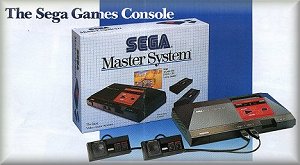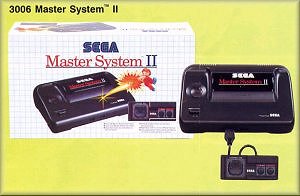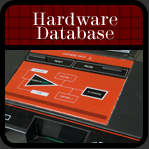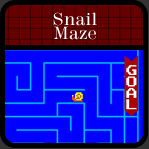
Forget any ideas you have about sending text messages from this website! When we talk about 'SMS' we're talking about the Sega Master System! What is the Sega Master System? It's a now classic 8-bit computer video game console made by Sega. The SMS was released into the western market in 1986; roughly six months after Nintendo released their NES.
The Sega Master System was a product of the Sega of Japan, the arcade giant at the time, but it wasn't the company's first system. Sega had prior experience in creating home consoles in the form of the Sega SG-1000 in 1983, the first home console they realeased. It's similar to earlier systems such as Colevision or the Intellivision. Sega later released an updated version of the console called the SG-1000 Mark II. Although both these consoles were never released outside of Japan they provided Sega with the experience and funding to create a better console.
Then, in 1985, Sega released the Sega Mark III, at the time the most advanced 8-bit console available. This time they had bigger ideas for their system after witnessing the success of the Nintendo NES in America and Europe. Sega decided to release a console overseas for the first time. With the help of Steve Hanawa they decided to re-design the Mark III to make it more appealing to the western market and were set to have it ready by Christmas of 1986. The result of this was the Sega Master System.
The Master System was technically superior to the NES and had the following specifications:
Bits (CPU): 8
Bits (Gx): 8
CPU: Z80
MHz: 3.58
Graphics: 256 x 192
Colours: 32 + 32
Sprites: 64
Sprite size: 8x8 or 8x16
Audio: 3 music + 1 noise
 |
|
Master System Mark 1
|

|
|
Master System Mark 2
|
Sega released their shiny new Master System in America and Europe in 1986, around six months after the Nintendo Entertainment System hit stores. At this time Nintendo forced the software developers to sign contracts which meant they could not develop games for any other system except the NES. This had the effect of limiting the amount of software that could be developed for the SMS; Nintendo's contracts were later declared illegal, but by that time the Nintendo NES platform had become the dominant system in the USA. Still, Sega had by then released an impressive library of titles both in the United States and abroad, but especially in Brazil, where the system lasted until roughly 1997 and still exists in classic, multi-game consoles. If you want to see a little of what the Master System could do, check out our Games Database.
Shortly after their problems with Nintendo and during a downhill slide in sales in the United States, Sega of America sold their rights to distribute Sega products to a well known toy company called Tonka believing they could market the console better. Tonka was able to secure a small, but stable, position for the Master System with the help of the marketing skills of John Sauer, and a horde of dedicated employees. Sega did buy back the rights to the Master System near the beginning of the 1990s, but by then the market in USA had moved on to more powerful 16-bit systems. Near the end, Sega utilized what they had learned from Tonka's marketing and repackaged several games as they phased out the system while the Genesis slowly came to the front of the video game world.
In the United States, the Master System was not as strong of a seller as the NES, but it still managed to gather a loyal following. In Europe, however, the Master System sold very well, in some countries far outselling the Nintendo NES. In the late 80's and early 90's masses of games were developed for the European market by various developers, leading to classic titles unknown to most NTSC collectors. In Brazil, it was the dominant system, its popularity due to the ingenious marketing skills of Tec Toy, who still continues to make money off of various SMS titles and even occasionally develops new ones for their various 'collection' consoles.
Chances are, if you're here, you're looking to learn a little about the Master System. This brief history may eventually be built upon, but it's certainly sufficient for you before you get into the nitty-gritty of the site. If you haven't yet, join the forum and get to know some of the older members who have been around for awhile, trade, sell, and otherwise keep the system alive. We're all interested in preserving the history of this great system and even today unearth previously unknown tidbits of history, get information from former programmers and the like. So, if you're starting, you're at the right place!
<< Back to Main Index





